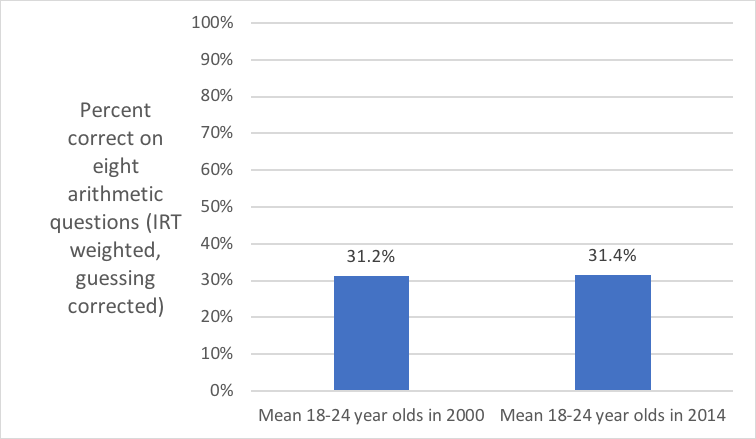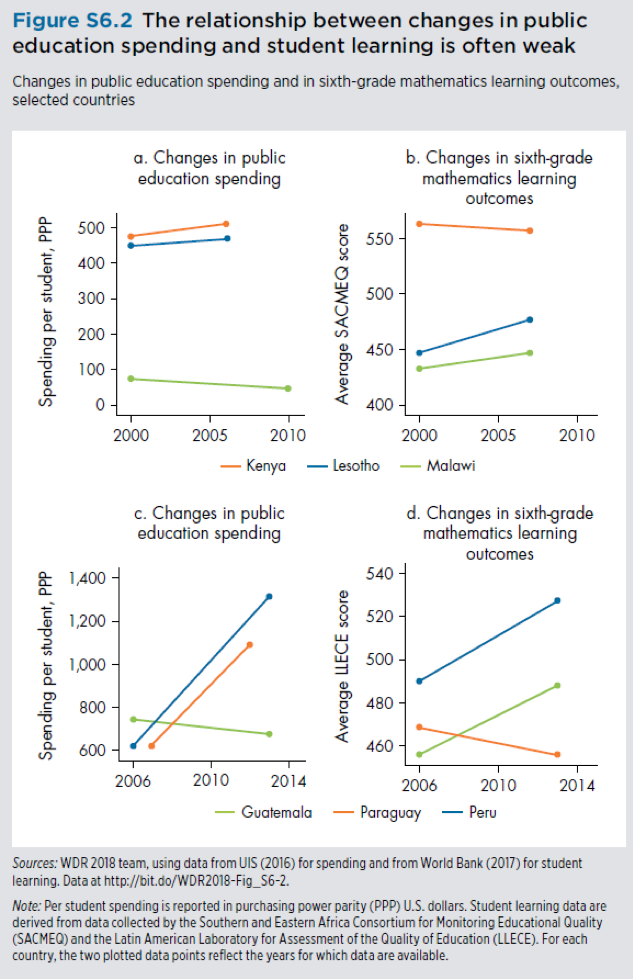Michelle Kaffenberger
Blavatnik School of Government, University of Oxford
Blog
The World Bank’s new Human Capital Index (HCI), launched at the Annual Meetings last week, explicitly recognizes that schooling that produces learning is needed to build human capital. Rather than including only average years of schooling as the proxy for education-based human capital, it uses a quality-adjusted measure of schooling, recognizing that all schooling isn’t the same, and too often, “schooling ain’t learning”.
This is a welcome reinforcement of the pivot to learning reflected in the World Development Report 2018 on Education and the Sustainable Development Goal (SDG) 4, which calls for universal quality primary and secondary schooling and literacy and numeracy for all youth (compared to the Millennium Development Goal which focused only on schooling attainment).
Because what gets measured gets done, and, I would add to the phrase, what gets measured gets funded and gets done, the creation of the HCI should rally resources and policy attention to the education sector. Additional funding is badly needed, but to truly expand human capital, this funding needs to be invested in reforms to education systems that produce learning, not just spent on “more of the same” kinds of schooling inputs.
Governments can spend money in all sorts of ways that aren’t productive and don’t produce capital. Pritchett (2000) shows the harms of equating spending with investing for physical capital. Nigeria spent billions to build the Ajaokuta Steel mill, but it never produced any steel. That spending appeared in the government budget as “investment” but was it really investment? It didn’t create any valued capital. The infamous Morogoro Shoe factory in Tanzania cost tens of millions to build but peaked at 4 percent of planned capacity. Money was borrowed, spending was called “investment” but was it really investment? It did not create any valued capital. Table 1, from the paper, shows that among World-Bank-funded investments in select countries, the median rate of return varied from zero to 19.5 percent—representing very different value per dollar spent. Clearly the capital produced depends not just on the amount spent, but on the efficacy of the investment: Was the money spent on the right things? In the right way?

The same can be said for spending on education. Money spent on education does not necessarily and directly produce human capital. Instead the human capital produced depends on the efficacy of the investment.
In India, for example, the efficacy of government spending on schooling has been shown to be much lower than private spending – government schools spend (on average) more than twice as much per student than private schools and produce less learning. Is all the extra spending really investment in human capital? No. Instead much of the spending goes to rents. Teacher absenteeism is one obvious form of rents, when teachers are paid regardless of whether they show up to work, but rents take other forms as well. They also include teachers who are at the school but not teaching, teachers who are teaching but not effectively, and civil servant teachers who are paid more than is necessary to attract and retain quality teachers. One analysis estimated that the fiscal cost in India of teacher absenteeism alone is $1.5 billion per year. This spending isn’t “investment in human capital.”
In another example, the Indonesian government undertook major reforms beginning in 2000 that included tripling education expenditures in real terms, doubling teacher salaries, and extending compulsory schooling from six to nine years (among other reforms). Schooling attainment increased considerably, with many more children starting and finishing secondary school. Yet learning barely budged. Learning levels actually fell slightly, and the average percent correct out of eight math questions among 18-24-year-old (in a nearly nationally representative survey) increased by only 0.2 percentage points (See Figure 1).
Further, a study aptly called “Double for Nothing?” found that the doubling of teacher salaries in Indonesia had no impact on student learning. The massive increases in spending and enrollment resulted in almost no additional skills.
Figure 1. Despite major increases in spending and school enrollment, learning barely budged (Based on the Indonesian Family Life Survey (IFLS) in 2000 and 2014)

The World Bank’s World Development Report 2018 on education emphasized the heterogeneity in the relationship between spending and learning. Figure S6.2 from the report (below), shows for example that while Kenya and Lesotho both increased spending in the early 2000s, in Lesotho learning increased while in Kenya learning declined. Paraguay is another striking example. A near doubling of spending per student corresponded with a drop in average learning. In Peru, a similarly large increase in spending led to significant improvements in average learning. Clearly not all spending is created equal.

More spending on “business-as-usual” schooling inputs also has often been shown to produce little to no additional capital, often because the systems they are provided to are not aligned for learning. For example, providing more textbooks had no impact on learning in Kenya or Sierra Leone. Reducing class sizes for civil servant teachers (e.g., by providing more teachers) had no impact on learning in Kenya or India. A systematic review of education interventions by 3ie states, “The results suggest a relatively consistent pattern of no effects [of providing school materials] on learning outcomes, as measured by maths, language and composite test scores”. Inputs are of course critical ingredients for quality schooling, but they are not sufficient to ensure positive outcomes.
Does this evidence mean more spending isn’t needed? Or more inputs aren’t needed? Of course not. More resources for education are desperately needed. What this evidence shows is that funding needs to be invested in things that will produce human capital, rather than simply spent on business-as-usual schooling inputs. To do this, education systems need to be re-oriented towards learning, so that incentives and accountability are aligned towards improving learning outcomes. The RISE research program is working to identify effective ways to do just this. The increased focus by the World Bank on human capital is welcome as the need for more investment in human capital is indeed great but, when “schooling ain’t learning” then “more (business-as-usual) spending ain’t investment.”
RISE blog posts and podcasts reflect the views of the authors and do not necessarily represent the views of the organisation or our funders.